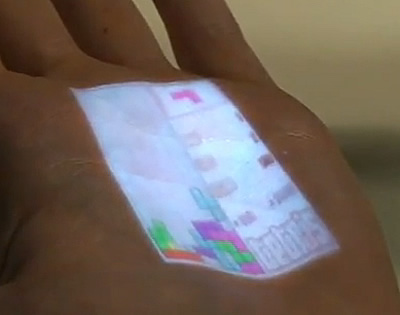Science Fiction
Dictionary
A B C D E F G H I J K L M N O P Q R S T U V W X Y Z
Skinput Uses Your Skin As An Input Device

Skinput is a new input device developed at Carnegie Mellon University in cooperation with Microsoft's research lab in Redmond, Washington. If you think that being able to "hold the Internet in your hand" with the iPhone is cool, you'll like controlling your Internet experience with your skin better.
The Skinput system uses two technologies to turn your biggest organ into a workable input device. Tiny pico projectors display choices onto your forearm, and an acoustic detector in an armband detects the ultralow frequency sounds produced by tapping the skin with your finger.
Take a look at this nicely produced explanatory Skinput video.
(Skinput video)
Here, the user plays tetris on the palm of his hand.

(Skinput tetris on palm)
Although not quite the same technology, this reminds me of the "readout skin" from John Varley's 1992 novel Steel Beach:
Call me old-fashioned. I'm the only reporter I know who still uses his handwriter except to take notes…I snapped the fingers of my left hand… Three rows of four colored dots appeared on the heel of my left hand. By pressing the dots in different combinations with my fingertips I was able to write the story in shorthand, and watch the loops and lines scrawl themselves on a strip of readout skin on my wrist, just where a suicide would slash himself.
Scroll down for more stories in the same category. (Story submitted 3/2/2010)
Follow this kind of news @Technovelgy.| Email | RSS | Blog It | Stumble | del.icio.us | Digg | Reddit |
Would
you like to contribute a story tip?
It's easy:
Get the URL of the story, and the related sf author, and add
it here.
Comment/Join discussion ( 0 )
Related News Stories - (" Input Device ")
MIT Headset Lets You Communicate Without Speaking
'The subvocal read nerve signals, letting her enter words by just beginning to will them...' - David Brin, 1990.
Tongue Mouse Created By Valve Engineer
'He pressed hard with his tongue against his right upper first molar.'- Alfred Bester, 1956.
Skinput Uses Your Skin As An Input Device
Nifty input technology takes advantage of your biggest organ to provide you with easy input.
AcceleGlove Open-Source Data Glove
This device was developed at great expense by your government, and now you can have one at a very reasonable price; developers use Java to program it.
Technovelgy (that's tech-novel-gee!) is devoted to the creative science inventions and ideas of sf authors. Look for the Invention Category that interests you, the Glossary, the Invention Timeline, or see what's New.
Science Fiction
Timeline
1600-1899
1900-1939
1940's 1950's
1960's 1970's
1980's 1990's
2000's 2010's
Current News
The Zapata Air Scooter Would Be Great In A Science Fiction Story
'Betty's slapdash style.'
Thermostabilized Wet Meat Product (NASA Prototype)
There are no orbiting Michelin stars. Yet.
Could Crystal Batteries Generate Power For Centuries?
'Power could be compressed thus into an inch-square cube of what looked like blue-white ice'
India Ponders Always-On Smartphone Location Tracking
'It is necessary... for your own protection.'
Amazon Will Send You Heinlein's Knockdown Cabin
'It's so light that you can set it up in five minutes by yourself...'
Is It Time To Forbid Human Driving?
'Heavy penalties... were to be applied to any one found driving manually-controlled machines.'
Replace The Smartphone With A Connected Edge Node For AI Inference
'Buy a Little Dingbat... electropen, wrist watch, pocketphone, pocket radio, billfold ... all in one.'
Artificial Skin For Robots Is Coming Right Along
'... an elastic, tinted material that had all the feel and appearance of human flesh and epidermis.'
Robot Guard Dog On Duty
I might also be thinking of K-9 from Doctor Who.
Wearable Artificial Fabric Muscles
'It is remarkable that the long leverages of their machines are in most cases actuated by a sort of sham musculature...'
BrainBridge Concept Transplant Of Human Head Proposed
'Briquet’s head seemed to think that to find and attach a new body to her head was as easy as to fit and sew a new dress.'
Google's Nano Banana Pro Presents Handwritten Math Solutions
'...copy was turned out in a charming and entirely feminine handwriting.'
Edible Meat-Like Fungus Like Barbara Hambly's Slunch?
'It was almost unheard of for slunch to spread that fast...'
Sunday Robotics 'Memo' Bot Has Unique Training Glove
'He then started hand movements of definite pattern...'
Woman Marries Computer, Vonnegut's Dream Comes True
'Men are made of protoplasm... Lasts forever.'
Natural Gait With Prosthetic Connected To Nervous System
'The leg was to function, in a way, as a servo-mechanism operated by Larry’s brain...'
